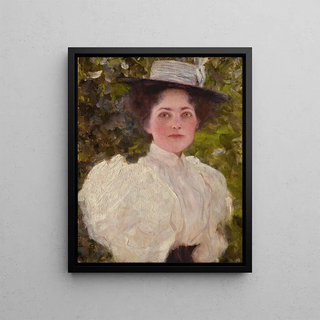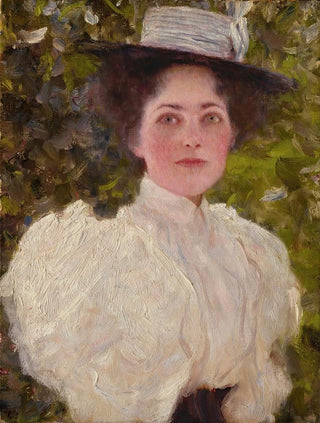Art print | Girl in Green - Gustav Klimt


View from behind

Frame (optional)
In the fascinating universe of art, certain works stand out for their ability to capture the very essence of human emotion. "Fille en vert" by Gustav Klimt is one of those iconic creations that transcend time and space. This canvas, created in 1907, evokes delicate beauty and palpable sensuality, while fitting into the artistic movement of the Vienna Secession. Klimt, with his inimitable style, manages to fuse symbolism and decorative art, creating a piece that resonates with the viewer in an intimate and personal way. The depiction of a young woman dressed in green, surrounded by a mysterious background, invites contemplation and interpretation, making this work a true masterpiece.
Style and uniqueness of the work
Klimt's style is recognizable among a thousand, blending various influences ranging from symbolism to Art Nouveau. "Fille en vert" is characterized by a vibrant color palette and bold use of decorative motifs. The young woman, at the center of the composition, is draped in a gown adorned with floral and geometric patterns, typical of the artist's style. This stylistic choice is no coincidence; it emphasizes harmony between the subject and her environment, while revealing psychological depth. The flowing lines and organic shapes create a movement that draws the eye and invites exploration of the details. The texture of the paint, almost tactile, enhances the impression of closeness to the subject, while the background, both rich and enigmatic, evokes a dreamlike universe where dream and reality intertwine. Thus, "Fille en vert" stands out as a work where beauty and art come together in a harmonious dance.
The artist and his influence
Gustav Klimt, an emblematic figure of Austrian art, left an indelible mark on the art world. Born in 1862, he established himself as one of the masters of the early 20th century, exploring various themes such as love, death, and femininity. His innovative approach, which blended

Matte finish

View from behind

Frame (optional)
In the fascinating universe of art, certain works stand out for their ability to capture the very essence of human emotion. "Fille en vert" by Gustav Klimt is one of those iconic creations that transcend time and space. This canvas, created in 1907, evokes delicate beauty and palpable sensuality, while fitting into the artistic movement of the Vienna Secession. Klimt, with his inimitable style, manages to fuse symbolism and decorative art, creating a piece that resonates with the viewer in an intimate and personal way. The depiction of a young woman dressed in green, surrounded by a mysterious background, invites contemplation and interpretation, making this work a true masterpiece.
Style and uniqueness of the work
Klimt's style is recognizable among a thousand, blending various influences ranging from symbolism to Art Nouveau. "Fille en vert" is characterized by a vibrant color palette and bold use of decorative motifs. The young woman, at the center of the composition, is draped in a gown adorned with floral and geometric patterns, typical of the artist's style. This stylistic choice is no coincidence; it emphasizes harmony between the subject and her environment, while revealing psychological depth. The flowing lines and organic shapes create a movement that draws the eye and invites exploration of the details. The texture of the paint, almost tactile, enhances the impression of closeness to the subject, while the background, both rich and enigmatic, evokes a dreamlike universe where dream and reality intertwine. Thus, "Fille en vert" stands out as a work where beauty and art come together in a harmonious dance.
The artist and his influence
Gustav Klimt, an emblematic figure of Austrian art, left an indelible mark on the art world. Born in 1862, he established himself as one of the masters of the early 20th century, exploring various themes such as love, death, and femininity. His innovative approach, which blended






